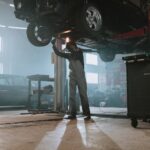Restoring a car involves a variety of potentially hazardous tasks. From dealing with flammable substances to operating heavy machinery, ensuring a safe workspace makes all the difference in a successful project. Use these essential safety tips and best practices to set up a car restoration workshop that encompasses proper ventilation, fire safety, and personal protective equipment (PPE).
Importance of Ventilation
Proper ventilation is crucial to a car restoration workshop. Many tasks, such as painting, welding, and using solvents release harmful fumes and gases. Inadequate ventilation can lead to respiratory issues, dizziness, and long-term health problems. Ensuring a constant supply of fresh air can help to mitigate these risks.
Ventilation Systems
A well-designed ventilation system can range from simple exhaust fans to more sophisticated systems like downdraft tables and paint booths. Positioning fans to direct fumes away from the workspace and workers is key. For tasks like spray painting, a dedicated spray booth with a high-efficiency particulate air (HEPA) filtration system is ideal. These booths contain and filter overspray, protecting both the restorer and the environment.
Natural Ventilation
Whenever possible, take advantage of natural ventilation. Open doors and windows to create cross-ventilation, which can help dissipate fumes and maintain air quality. However, natural ventilation should supplement—not replace—mechanical systems, especially for tasks generating significant fumes or dust.
Fire Hazards in Restoration Workshops
Car restoration involves numerous fire hazards. Flammable liquids, electrical equipment, and welding activities can all ignite fires if not managed properly. Identifying and mitigating these risks is essential for a safe workshop.
Storage of Flammable Materials
Flammable materials such as gasoline, paint thinners, and solvents should be stored in approved safety containers. These containers are designed to prevent spills and minimize the release of vapors. Additionally, store these containers in a designated flammable materials cabinet, away from heat sources and electrical equipment.
Electrical Safety
Ensure that all electrical outlets, cords, and tools are in good condition. Avoid overloading circuits and using damaged equipment. Extension cords should be used sparingly and never as a permanent solution. Regularly inspect all electrical components and replace any that show signs of wear or damage.
Welding and Cutting Safety
Welding and cutting generate sparks and high heat, posing a significant fire risk. Keep a fire extinguisher rated for electrical and flammable liquid fires within reach. Ensure that the workspace is clear of flammable materials before starting these tasks. Additionally, use welding screens to contain sparks and wear appropriate protective gear.
Fire Extinguishers and Emergency Plans
Equip your workshop with multiple fire extinguishers, ensuring that they are easily accessible and regularly maintained. Familiarize yourself and any coworkers with their location and proper use. Develop an emergency plan that includes evacuation routes and procedures, and conduct regular fire drills to ensure that everyone knows how to respond in case of a fire.
Importance of PPE
Personal protective equipment (PPE) is the first line of defense against the hazards present in a car restoration workshop. Proper use of PPE can prevent injuries and long-term health issues, making it an indispensable aspect of workshop safety.
Eye and Face Protection
Eye protection is critical when working with tools, chemicals, or any activity that can generate flying debris or splashes. Safety glasses with side shields provide basic protection, while full-face shields offer additional coverage during grinding, cutting, or chemical handling. For welding, use a welding helmet with the appropriate shade to protect your eyes from intense light and sparks.
Respiratory Protection
Depending on the task, respiratory protection may be necessary to prevent inhaling harmful dust, fumes, or vapors. Dust masks are suitable for sanding and grinding, while respirators with appropriate filters should be used for painting, welding, and handling chemicals. Ensure that the respirator fits properly and is rated for the specific hazards you are dealing with.
Hearing Protection
Long-term exposure to loud noises from machinery and tools can cause permanent hearing damage. Use earplugs or earmuffs to protect your hearing, especially when operating noisy equipment like air compressors, grinders, or power tools.
Hand Protection
Hands are particularly vulnerable to injury in a workshop environment. Different tasks require different types of gloves. Nitrile or latex gloves are suitable for chemical handling, while leather gloves provide protection against cuts and abrasions during metalworking or using hand tools. Ensure that you choose the right gloves for the task at hand.
Protective Clothing and Footwear
Wear durable, flame-resistant clothing to protect your skin from sparks, hot metal, and chemicals. Avoid loose clothing and jewelry that can get caught in machinery. Steel-toed boots with slip-resistant soles are essential to protect your feet from heavy objects and slick surfaces.
Cleanliness and Organization
A clean and organized workspace reduces the risk of accidents. Keep tools and materials properly stored when not in use, and ensure that walkways are clear of obstructions. Regularly clean up spills and debris to maintain a safe working environment.
Tool Maintenance
Regularly inspect and maintain tools and equipment to ensure that they are in good working condition. Damaged or worn-out tools can malfunction and cause injuries. Follow the manufacturer’s maintenance guidelines and replace any equipment that cannot be safely repaired.
Safe Lifting Practices
Restoring cars often involves lifting heavy parts and equipment. Use proper lifting techniques to avoid injury. Lift with your legs—not your back—and seek assistance or use lifting equipment like hoists or jacks for heavy or awkward items.
Ensuring a safe car restoration workspace requires careful planning, adherence to safety protocols, and a commitment to maintaining a hazard-free environment. By focusing on proper ventilation, fire safety, and the use of personal protective equipment, restorers can protect themselves and their workshops from the inherent risks of the restoration process.
